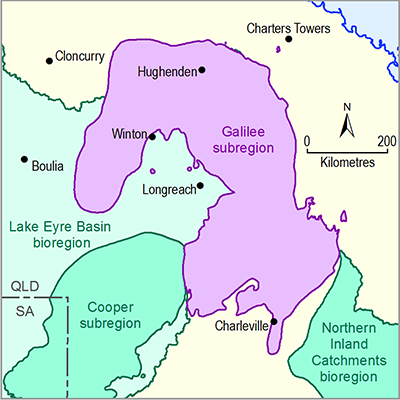Summary
In bioregional assessments (BAs), receptor impact models are developed to characterise potential ecosystem changes that may result from hydrological changes predicted in response to coal resource development. A receptor impact model is constructed for one or more landscape classes (or landscape groups). A landscape class represents ecosystems with similar water dependencies that are expected to respond similarly to changes in groundwater and/or surface water. Only landscape classes that intersect the zone of potential hydrological change are considered as candidates for receptor impact models. Outside the zone, hydrological changes are considered too small to result in adverse impacts to water-dependent ecosystems.
The potential impacts of coal resource development on ecological assets are initially assessed using qualitative mathematical models. These models are elicited from independent experts and contain key components and processes of the landscape class ecosystems, and the hydrological variables that support them. They are then used to qualitatively predict (reported as increase, decrease or no change) how the landscape class ecosystem will respond to changes in hydrology that may occur as a result of coal resource development.
The receptor impact modelling process continues with the selection of receptor impact variables from the ecological components or processes identified in the qualitative mathematical model, and the hydrological response variables to represent the hydrological regimes that support these components or processes. Thus the landscape classification and qualitative mathematical models provide the framework for elicitations to quantify potential changes in receptor impact variables in response to changes in hydrological response variables for subsequent model predictions.
The elicitation process allows for the construction of a statistical model that predicts how changes in the hydrological response variables due to coal resource development will impact the receptor impact variables. Within a landscape class, this statistical model enables the BA team to quantify the risk to ecological assets from coal resource development using predicted changes in hydrological response variables in a short-term (2013 to 2042) and long-term (2073 to 2102) assessment period.
The receptor impact models predict the distribution function of the receptor impact variables for different futures (baseline and coal resource development pathway) and at specific assessment years (2042 and 2102). The distribution functions are summarised in BAs by a limited series of percentiles (or quantiles), nominally 5% increments between the 5th and 95th percentiles.

Product Finalisation date
- 2.7.1 Methods
- 2.7.2 Overview
- 2.7.2.1 Introduction
- 2.7.2.2 Potentially impacted landscape groups
- 2.7.2.3 'Springs' landscape group
- 2.7.2.4 Streams landscape groups
- 2.7.2.5 'Floodplain, terrestrial GDE' landscape group
- 2.7.2.6 'Non-floodplain, terrestrial GDE' landscape group
- 2.7.2.7 Outline of content in the following landscape group sections
- References
- Datasets
- 2.7.3 'Springs' landscape group
- 2.7.4 Streams landscape groups
- 2.7.5 'Floodplain, terrestrial groundwater-dependent ecosystem' landscape group
- 2.7.6 'Non-floodplain, terrestrial groundwater-dependent ecosystem' landscape group
- 2.7.7 Limitations and gaps
- Citation
- Acknowledgements
- Contributors to the Technical Programme
- About this technical product
